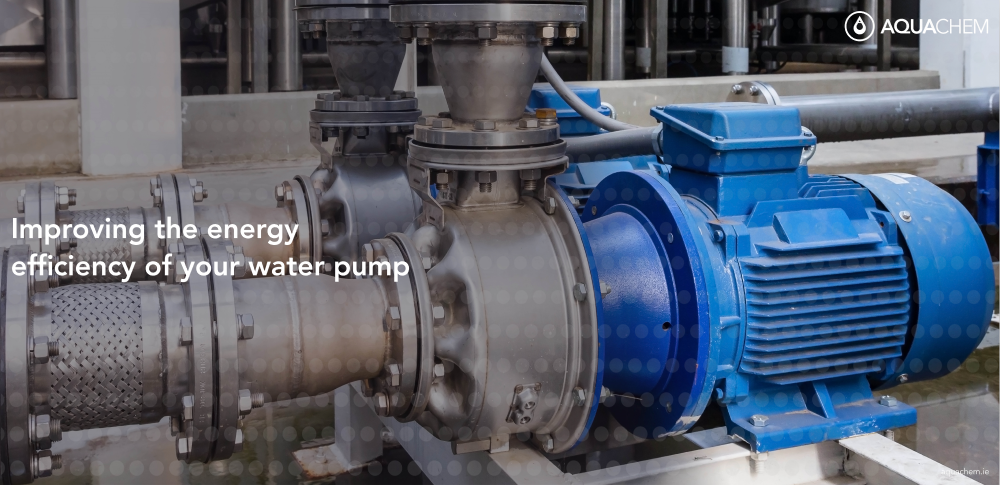Most types of industries, big or small, need pumping systems to meet their fluid, especially, water utility requirements and with research finding that 16% of a typical industrial facility’s electricity costs are generated by its pumping systems one can see why it is so important to ensure this is running as efficiently as possible.
Pumping systems should be designed to be as efficient and as energy saving as possible, keeping the individual needs and future demands in mind. Regular maintenance along with continuous monitoring will help you keep your system operating effectively and will detect problems within your pump which could be missed, such as
- Blockage, clogged pipes or pumps
- Damaged impellers
- Reduced suction
- Gas filled pipes or pumps
It is estimated that regular maintenance of a pumping system can save up to 7% of the total electricity used for pumping purposes.
Regular maintenance will increase the efficiency as well as the age of pumping system and usually includes:
- Impeller repair, or replacement if required
- Bearing inspection, lubrication, or replacement if required
- Packing seals inspection, or replacement if required
- Mechanical seals inspection, or replacement if required
- Pump and motor alignment inspection
- Throttling losses inspection
In this blog we will have a look at ways in which you can considerably increase the pumping performance (in turn saving energy and money), and what can cause pump failure – leading to downtime, repair and damage.
Improving Performance
1. Correct sizing
When faced with a new or application, it is often difficult to resist overdesign as no one wants to be the supplier that underperforms in a system. The tendency to overdesign—a little extra horsepower or a larger-than-necessary discharge pipe spool—can create waste and inefficiency because a higher performance (in terms of flow and pressure) requires more power from the motor, an oversized pump can result in unnecessary energy consumption.
Whilst a degree of oversizing may be good common sense to compensate for uncertainties, selecting a pump that will be operating as close to its Best Efficiency Point as possible can significantly reduce energy usage.
In addition to the pump size, the pipe diameter is just as important to get correct; keeping costs at a minimum, proper pipe diameter can prevent sedimentation or settling of slurries. An optimally sized discharge line would be one that is large enough to control excess backpressure but small enough to prevent sedimentation in the pipeline.
2. Conduct an energy audit and life-cycle cost estimate
Whilst this seems obvious, it’s surprising how often pumps are in operation unnecessarily.
Control systems can be implemented to shut down pumps not in use and the use of pressure switches can control the number of pumps in service when duty requirements vary. This can ensure that multiple pumps aren’t in use at the same time, when the current system conditions only need one pump in action.
Before replacing a worn-out thickener underflow pump or a troubling absorber recycle pump, perform an energy audit to find the true cost of operation. Though many require higher initial capital investments, the life-cycle cost may prove more beneficial to the cost centre.
Remember: greater energy efficiency, less downtime, less maintenance and lower operating costs all make their way to the balance sheet. And do not be afraid to consider the use of new and alternate technologies.
3. Monitor pump performance
Gauges can be used in both the suction and discharge side of the pump. These serve as the best early warning of wear or poor performance caused by blockage or system anomalies.
A low discharge pressure could signify wear on internal pump components, leading to reduced efficiency. The gauges must be monitored and trigger maintenance or other remedial action when readings trend beyond the established control limits.
4. Limit pipework pressure loss
Optimising the system pipework to limit the frictional pressure drop is another way to save energy, as it reduces the power the pump requires to overcome such losses.
Pipe diameter, length, layout internal surface and components installed within the pipework all affect system pressure drop and therefore consideration should be given to these when looking at energy improvements.
At the design stage, attempts should be made to minimise the number of bends, expansions and contractions in the pipework, keeping the piping as straight as possible and the diameter the same. However, due to space constraints this is not always possible. Any fittings or valves specified for the installation should also have a relatively low pressure drop.
5. Variable frequency drives
As their name suggests, variable frequency drives vary the rotational speed of the motor to achieve the actual head and flow demand of the application, rather than what the pump can produce.
VFDs are typically used to limit unnecessary energy consumption in two scenarios; the first being to slow the motor down on a pump that has been oversized at specification stage.
The second use of a VFD is where there are differing duty demands on the pump at different times. When this is the case, the pump needs to be able to run at maximum capacity when required but may operate at less than this for long periods of time.
Although VSDs do come at a cost, usually the energy cost saving they can make justify the investment.
6. Conduct routine maintenance
Undertaking routine maintenance on your pump can also reduce energy consumption, as like with any equipment, wear can reduce efficiency.
Timely replacement of parts results in greater pump efficiency. Upkeep including the replacement of eroded wear rings is vital, as increased wear ring clearance increases leakage and therefore the pump power requirements to produce the same flow is increased.
A pump’s energy efficiency can degrade as much as 10-25% before it’s replaced!
7. Train the operators.
A well-trained operator is vital for efficient operation.
Train key staff members to ensure that system performance is monitored and that routine maintenance is performed to keep the system operating at its most efficient levels.
Pump Failure
Pump failure can result in costly downtime, repair and damage. Understanding the causes of failure can help in the selection of the pumping equipment to reduce the chances of it occurring.
1. Cavitation
Cavitation is the result of insufficient pressure at the suction end of the pump or Net Positive Suction Head Available (NPSHa) causing the liquid in a pump to turn into vapour at low pressure.
At low pressures, this creates air bubbles which implode as the liquid moves from the suction side of the impeller to the delivery side.
The air bubble implosion generates a shockwave that stresses the pumps’ internal surfaces, creating vibration and mechanical damage, and can ultimately result in failure.
When this occurs repeatedly, cavitation can cause pitting and fractures in the impeller, volutes and casing, weakening the metal, increasing resistance to flow and reducing pumping efficiency. The shock loads from cavitation can also decrease the service life of the shaft and motor.
Cavitation and the related problems it causes can greatly impact the life of a pump, reducing it by 10-15 years, or even more in extreme cases.
Cavitation is most easily avoided during the design stage, ensuring the chosen pump will have sufficient NPSHa so that the liquid remains above vapour pressure.
2. Corrosion
Corrosion in pumps is the result of a chemical reaction between the metal and the fluid being pumped.
This reaction can cause uniform corrosion of the wet surfaces – found mostly in pumps made from non-stainless-steel materials – or localised corrosion of a small portion of the components – occurring most commonly where metals that form oxide layers that adhere to and passivate the surface.
When corrosion occurs, pump performance and efficiency can be affected, increasing the need for more frequent maintenance and more downtime, and if left untreated it can lead to failure.
The key to mitigating corrosion is by selecting a pump manufactured from the most appropriate materials for the application. Material selection will determine corrosion resistance in a particular application as well as the pump’s overall cost, including initial cost, maintenance, replacement, downtime, lifecycle and reliability.
3. Fouling
Fouling occurs when particulate matter adheres to a pump’s internal surfaces, most commonly in the distribution lines connected to the intake or outflow.
When this occurs, pumping efficiency and flow capacity are decreased, and may eventually lead to failure. This is an unavoidable problem, but is more prevalent in applications where the fluid being pumped contains particles.
However, various cleaning methods can be used to maintain the pump and improve efficiency and capacity.
4. Wear
Wear is inevitable when running a pump, however, there are a few factors that can cause excessive wear, which speed up deterioration of the pump.
Particulate matter in the pumped fluid can lead not only to fouling but also increases the pace of wear on a pump.
These particulates scour a pump’s interior surfaces and roughens them, reducing pumping efficiency over time as it needs to work harder to move the fluid.
Eventually, the pump will become so worn that it will be unable to produce enough lift and may cause excessive vibration.
Wear can also be the result of an improperly sized pump which can cause an imbalance of pressure, putting undue stress on the bearings and seals; turbulence; fluid velocity; deterioration of wear rings; and erosion and corrosion.
Wear rate can be slowed down by ensuring the pump size and materials are suitable for the application, and regular maintenance is carried out to find and fix any problems before they result in unexpected downtime or pump failure.
Conclusion
With concerns for the environment growing as well as the ever increasing need to reduce costs, energy efficiency is an important topic for industry.
When it comes to water pumps, properly sizing systems, utilizing well-trained operators and performing routine maintenance can help overcome day-to-day challenges and help prolong equipment life span and efficiency.
Contact us to find out more on how we can help make sure your systems are running as efficiently as possible.









